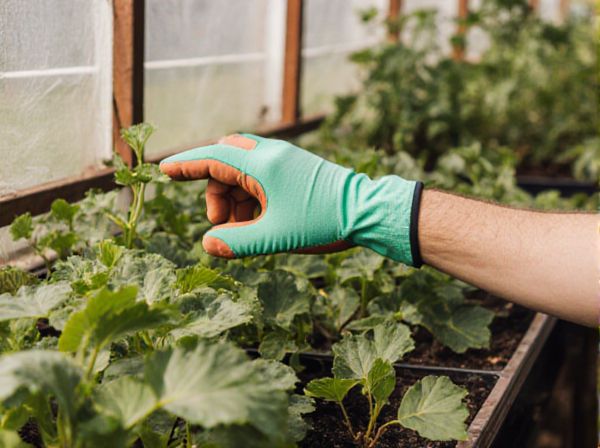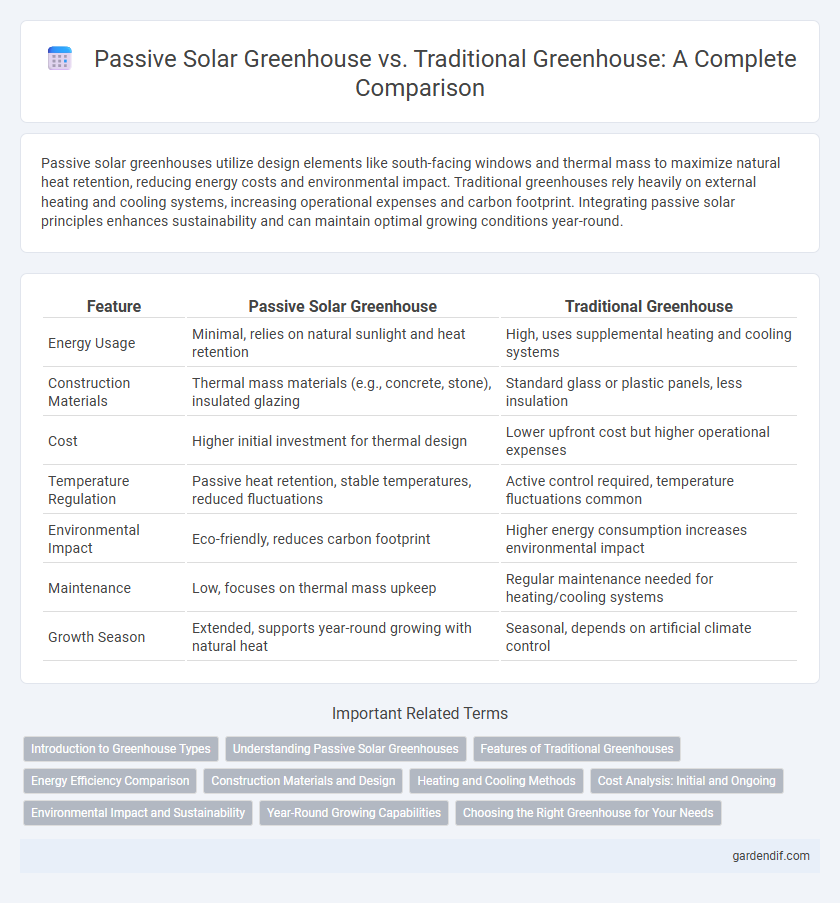
Passive solar greenhouse vs Traditional greenhouse Illustration
Passive solar greenhouses utilize design elements like south-facing windows and thermal mass to maximize natural heat retention, reducing energy costs and environmental impact. Traditional greenhouses rely heavily on external heating and cooling systems, increasing operational expenses and carbon footprint. Integrating passive solar principles enhances sustainability and can maintain optimal growing conditions year-round.
Table of Comparison
| Feature | Passive Solar Greenhouse | Traditional Greenhouse |
|---|---|---|
| Energy Usage | Minimal, relies on natural sunlight and heat retention | High, uses supplemental heating and cooling systems |
| Construction Materials | Thermal mass materials (e.g., concrete, stone), insulated glazing | Standard glass or plastic panels, less insulation |
| Cost | Higher initial investment for thermal design | Lower upfront cost but higher operational expenses |
| Temperature Regulation | Passive heat retention, stable temperatures, reduced fluctuations | Active control required, temperature fluctuations common |
| Environmental Impact | Eco-friendly, reduces carbon footprint | Higher energy consumption increases environmental impact |
| Maintenance | Low, focuses on thermal mass upkeep | Regular maintenance needed for heating/cooling systems |
| Growth Season | Extended, supports year-round growing with natural heat | Seasonal, depends on artificial climate control |
Introduction to Greenhouse Types
Passive solar greenhouses utilize solar energy through strategically placed south-facing glass and thermal mass materials to maintain optimal temperatures with minimal external energy input. Traditional greenhouses often rely on artificial heating and cooling systems to regulate the internal environment, leading to higher energy consumption. Understanding these differences is crucial for selecting a greenhouse type that balances energy efficiency and plant growth needs.
Understanding Passive Solar Greenhouses
Passive solar greenhouses maximize natural energy by using south-facing glass panels and thermal mass materials like stone or water barrels to absorb and retain heat, reducing reliance on external heating sources. Unlike traditional greenhouses that depend heavily on supplemental heating and ventilation systems, passive solar designs optimize natural sunlight and insulation to maintain a stable internal temperature. This sustainable approach enhances plant growth while lowering energy costs and environmental impact.
Features of Traditional Greenhouses
Traditional greenhouses feature transparent glass or plastic walls and roofs that maximize sunlight exposure while enabling controlled temperature and humidity. These structures rely heavily on external heating and cooling systems to maintain optimal growing conditions, often leading to higher energy consumption. Ventilation mechanisms such as roof vents and side windows provide essential airflow to regulate internal climate.
Energy Efficiency Comparison
Passive solar greenhouses utilize strategic orientation, thermal mass, and insulation to maximize solar energy absorption and minimize heat loss, significantly reducing reliance on external heating sources. Traditional greenhouses often depend on artificial heating and ventilation systems, resulting in higher energy consumption and operational costs. Energy efficiency in passive solar greenhouses can be up to 50% greater than that of traditional greenhouses, promoting sustainable agriculture and lowering carbon footprints.
Construction Materials and Design
Passive solar greenhouses utilize high thermal mass materials such as concrete, stone, or water barrels to absorb and store solar energy, reducing heating needs. Their design incorporates south-facing glass panels and insulated north walls to maximize sunlight capture and minimize heat loss. Traditional greenhouses often use lightweight materials like aluminum frames and single-pane glass, focusing on ventilation and artificial heating rather than solar energy efficiency.
Heating and Cooling Methods
Passive solar greenhouses use strategic orientation, thermal mass, and insulation to capture and retain solar energy, reducing reliance on external heating and minimizing energy costs. Traditional greenhouses typically depend on electric or gas heaters and mechanical ventilation systems for temperature control, resulting in higher operational expenses. Passive systems optimize natural heat distribution and airflow for cooling, whereas traditional designs use fans and vents powered by electricity to maintain internal climate.
Cost Analysis: Initial and Ongoing
Passive solar greenhouses require higher initial investments due to specialized materials like thermal mass and insulated glazing but offer significantly reduced ongoing energy costs by harnessing natural solar energy. Traditional greenhouses tend to have lower startup costs but incur higher operational expenses from continuous heating, cooling, and lighting needs. Over time, the cost efficiency of passive solar greenhouses generally outperforms traditional models, providing substantial savings in energy expenditure.
Environmental Impact and Sustainability
Passive solar greenhouses utilize natural sunlight and thermal mass to regulate temperature, significantly reducing the need for fossil fuel-based heating compared to traditional greenhouses. This energy-efficient design lowers greenhouse gas emissions, promoting sustainability through decreased carbon footprints and enhanced resource conservation. Traditional greenhouses often rely on artificial heating and cooling systems, increasing energy consumption and environmental impact.
Year-Round Growing Capabilities
Passive solar greenhouses utilize solar energy and thermal mass materials to maintain stable temperatures, enabling year-round growing without relying heavily on external heating systems. Traditional greenhouses often depend on supplemental heating and cooling, which can increase operational costs and limit sustainable year-round production. The enhanced energy efficiency and temperature regulation in passive solar greenhouses support continuous crop growth through all seasons, improving productivity and reducing environmental impact.
Choosing the Right Greenhouse for Your Needs
Passive solar greenhouses maximize energy efficiency by utilizing south-facing glass and thermal mass to capture and store solar heat, reducing heating costs significantly. Traditional greenhouses rely on external energy sources such as electric heaters or gas to maintain consistent temperatures, which can increase operational expenses. Selecting the right greenhouse depends on climate, budget, and sustainability goals, with passive solar models ideal for cold regions seeking eco-friendly solutions, while traditional greenhouses offer versatile control in varying environments.
Passive solar greenhouse vs Traditional greenhouse Infographic

 gardendif.com
gardendif.com